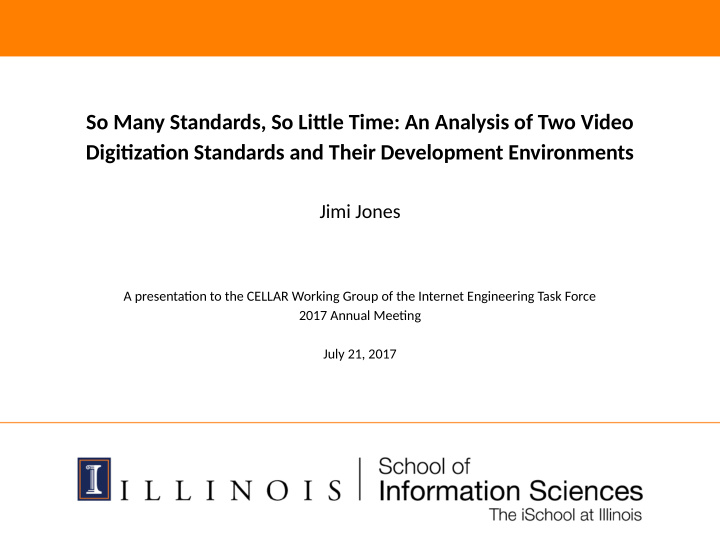



So Many Standards, So Litule Time: An Analysis of Two Video Digitjzatjon Standards and Their Development Environments Jimi Jones A presentatjon to the CELLAR Working Group of the Internet Engineering Task Force 2017 Annual Meetjng July 21, 2017
Introductjon • Doctoral dissertatjon for the School of Informatjon Sciences at the University of Illinois, Urbana-Champaign • Qualitatjve analyses of two examples of standards development and their implementatjon • Data gathering/research Fall 2017, Spring 2018 • Writjng Fall 2018, Spring 2019 2
Library Of Congress (FADGI) Standard • ‘AS-07’ developed to support the digitjzatjon efgorts at the Library, especially their AV facility in Culpeper, VA • Uses the MXF (Material Exchange Format) container and JPEG2000 lossless compression for picture essence • Developed with considerable input from American television broadcast community (AMWA - Advanced Media Workfmow Associatjon) 3
CELLAR Standard • Is being developed by American and European archivists (CELLAR working group) and video digitjzatjon vendors • Adapts open-source Matroska (MKV) multjmedia container and FF Video Codec 1 (FFV1) lossless video compression codec • This is where you come in! 4
Research Questjon 1 How do power and infmuence dynamics afgect these two groups as they create standards and defjne quality and sustainability for moving image preservatjon? 5
Interview Concepts Research Questjon 1 • How do the standards development groups negotjate their defjnitjons of quality with respect to digital video? • Do the groups have leaders? If so, how are the leaders assigned? What are the power dynamics? • Do archivists, engineers and preservatjon specialists have difgering notjons of quality and sustainability? How are these difgerences negotjated and how do they inform the resultant standards? 6
Research Questjon 2 What roles do these standards play in the moving image preservatjon community’s video digitjzatjon work? 7
Interview Concepts Research Questjon 2 • What factors inform preservatjon professionals’ decisions of which standard(s) to use for video digitjzatjon? • Do the digitjzatjon standards work ‘as is’ or do they need to be adapted for local practjce? What are those adaptatjons? 8
Data Gathering Interviews with standards developers and/or implementers (via Skype and/or in person at 2017 AMIA conference in New Orleans) Site visits with implementers of AS-07 or MKV/FFV1 combinatjons - Indiana University and LOC Culpeper (so far) Review of documentatjon related to standards development and/or implementatjon - specifjcatjons, drafus, meetjng minutes, best practjce documents, etc 9
Closing Absolutely, positjvely NOT about which standard is ‘betuer.’ Absolutely, positjvely NOT about which development group is ‘betuer.’ This is about how the groups operate and how and why the standards are (or are not) being implemented 10
Closing If you would like to partjcipate in my work, please contact me at jjones7@illinois.edu Thank you for lettjng me observe your meetjng today! 11
Selected References Federal Agencies Digital Guidelines Initjatjve (FADGI). (2010). Audio-Visual Format Documentatjon Project: Background Paper. Available at: htup://www.digitjzatjonguidelines.gov/guidelines/FADGI-AV_AppSpecProj_Bkgd_101007.pdf. Accessed on March 7, 2017. MediaConch. htup://www.preforma-project.eu/mediaconch.html. Accessed on March 7, 2017. Mosco, Vincent. (2009). The Politjcal Economy of Communicatjon: Rethinking and Renewal . Thousand Oaks, CA: Sage Publicatjons. Pinch, Trevor J. and Wiebe E. Bijker. (1987). “The Social Constructjon of Facts and Artjfacts: Or How the Sociology of Science and the Sociology of Technology Might Benefjt Each Other”. In The Social Constructjon of Technological Systems . Cambridge, MA: MIT Press. 17-50. Sterne, Jonathan. (2012). MP3: The Meaning of a Format . Durham, North Carolina: Duke University Press. Woolgar, S. (1990). Confjguring the user: the case of usability trials. The Sociological Review, 38(S1), 58–99. 12
Recommend
More recommend